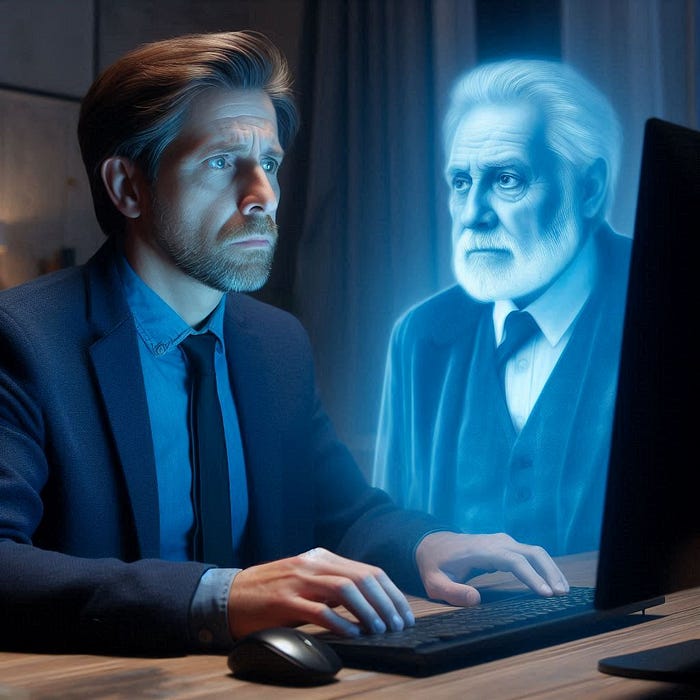Harry Houdini’s Warning About The AI Afterlife Industry
What early 1900s séances can teach us about a new world of ghost-bots

It was eerily silent in the large marble-covered room like no one wanted to be the first to speak. My brothers and I were at a funeral home, planning my mother’s wake. Everything was so surreal.
Suddenly, in the middle of my grief, a salesman’s voice chimed in, discussing options, such as upgraded flowers, caskets, and enlarged collages of memorable pictures.
I had no idea what we’d choose, but I knew one thing for certain: this character had the dollar amount of my mom’s life insurance policy in front of him, and he planned to spend every penny for us.
We’d been through this before with my father’s funeral. Through both, we quickly learned that those with interest can easily manipulate people’s grief and the means to do so.
That’s why a new technology is giving me pause.
I’m sure you’ve noticed AI is creeping its way into everything. This now includes death. Companies like Storyfile and Eternos are using algorithms to recreate dead loved ones, and the quality depends on what you’re willing to pay.
While these “ghost-bots” may comfort the living in a time of need, I can’t help hearing that salesman’s voice offer a possible new AI option for our mom where we’d never have to say goodbye for a fee. It also made me realize that a warning fromHarry Houdiniabout a hundred years ago has suddenly become relevant in our age.
While the great magician and escape artist never saw a computer, he understood how grieving people could be manipulated with promises of contacting loved ones. They’d give anything to someone with that power.
The Power Of A Séance
“I saw and felt that the audience believed in me…they believed that my tricks were true communications from those dead. …I was brought to a realization of the seriousness of trifling with the hallowed reverence which the average human being bestows on the departed…I was chagrined that I should ever have been guilty of such frivolity and for the first time realized that it bored on crime.”
— Harry Houdini in The Secret Life Of Houdini: The Making of America’s First Superhero, William Kalush and Larry Sloman
Erik Weisz (Harry Houdini) was born in Hungary in 1874 and immigrated to America at four with his family. His father, Mayer, worked as a rabbi for a congregation in Wisconsin but lost his job, and the family fell into destitute poverty. They eventually moved to New York.
Mayer died when Harry was eighteen and made the boy promise to take care of the family. Performing seemed like the best way out of poverty.
The future Houdini studied magicians, but escape arts truly caught his attention. His ability to break out of shackles and prison cells wowed onlookers and got him booked with traveling entertainers, although another fad was sweeping America, too.
Spiritualism, a movement that claimed people with special powers could contact the dead to exchange messages with the living through various means, created a sensation, and mediums appeared across the country. Houdini became interested — since he wanted to talk to his dead father — but every medium he met was a fraud.
However, the magician realized it was a money-making opportunity and studied a book calledThe Revelations of a Spirit Mediumby an anonymous author named “A. Medium.” It disclosed all the tricks used for clairvoyance, simulating supernatural acts, and speaking to spirits.
Within a year, Houdini and his wife were experts, and in 1895, they introduced spiritualism into their act. Their big secret was a bit of detective work and diligent research.
Houdini visited graveyards before acts to study local family histories.
He sold new Bibles to look at old Bibles within households with family trees.
Houdini sought out gossip at nearby rooming houses before performances.
He even paid local busybodies for information about the townsfolk.
The couple made a small fortune from grieving victims and shocked onlookers who didn’t realize their secret knowledge came from snooping. Houdini was so convincing he even made solving local murders by contacting the dead part of his show.
His low point came when he saw the fresh grave of six-year-old Joe Osbourne before a performance and claimed to speak to the child. The parents were in the audience. Mr. Osbourne was irate and later went backstage to pummel Houdini, but the magician’s wife stepped in.
She knew the child’s nickname and that Mrs. Osbourne was pregnant again, along with other family secrets. Afterwards, the father left mystified, believing they could speak to spirits.
Not long after, Houdini quit the spiritualism act and devoted the rest of his life to debunking predatory mediums. He even testified before the U.S. Congress, trying to get a law passed that would prevent people from telling fortunes for money.

Houdini found you could manipulate people to extreme degrees if they thought you had supernatural powers. In Kalush and Sloman’s book, Houdini even claims Czar Nicholasofferedhim an advisor position after a mind-blowing performance in Russia — the position Rasputin later held.
I see many similarities between the modern “ghost-bot” phenomenon and the Spiritualist mediums a hundred years ago.
AI Recreating The Dead
“What truly sets this era apart — and is even unprecedented in the long history of humanity’s quest for immortality — is that, for the first time, the processes of caring for the dead and immortalization practices are fully integrated into the capitalist market.”
— Katarzyna Nowaczyk-Basinska, University of Cambridge’s Centre for the Future of Intelligence, interview by the Associated Press
While the idea of AI replicating dead loved ones may sound like sci-fi, it’s happening now. In their article above, reporters Kirsten Grieshaber and Haleluya Hadero tell the story of a man named Michael Bommer, who is dying of colon cancer. He’s spending part of his remaining time speaking into a computer.
For a fee of $15,000, an AI firm called Eternos is creating an interactive AI avatar or “ghost-bot” for Bommer to leave to his wife. But this is a higher-end replication; others cost much less.
Storyfile creates prerecorded videos, sorted by algorithm depending upon the interaction.
“Project December” creates a chatbot with information about the person you miss. You can then talk to this replicated bot for $10.
Another company, appropriately named Seance, allows you to attend a fictionalized séance for free. AI versions of loved ones' voices and other options can be added for fees—like an in-app purchase in World of Warcraft.
In his article for The Conversation, assistant professor of psychotherapy Nigel Mulligan cautions that these ghost-bots may interfere with the grieving process.
He says grief over the loss of loved ones goes through stages that may take years to play out. Sometimes, there’s a sense of guilt. Other times, if the person died young or in a tragic way, mourners may not be able to accept it. This is referred to as “complicated grief.”
Mulligan believes ghost bots may further extend this type of grief. He says it can be healthy to forget. However, data rarely goes away, and these ghost-bots may make it harder to move on, although Sun Kai disagrees.
Sun, the co-founder of Silicon Intelligence, an AI firm in China, talks with his mother once a week. She died over five years ago, and Sun created an avatar of her. While it doesn’t move or say much, the interaction gives him peace.
However, he admits that his mom's memory and the avatar's image have started to blur. There are also other practical issues.
Grieshaber and Hadero say Storyfile went bankrupt, so what happens to their ghost-bots? While a court may consider them property, a grieving relative may associate that avatar with a real person, not a paid add-on like you’d experience in a video game.
That’s where this association can get dangerous. Harry Houdini might point out that a company or individual with ill intent could use that connection with the avatar to bilk someone out of money or even manipulate them.
One could only imagine what “options” a salesman at a funeral home might get you to pick when you’re not thinking rationally. Then again, how much bitcoin could a hacker fetch if they stole the daughter you tragically lost in an accident?
This is a complex and sensitive subject, so let’s conclude with a summary and another point about technology.
Houdini And The Possible Dangers Of AI Resurrection
In 1964, a computer scientist from MIT named Joseph Weizenbaum created the first chatbot, Eliza. The bot mimicked a Rogerian psychotherapist. This type of therapist helps patients by asking questions and getting them to inadvertently solve their problems.
The bot worked on a mainframe and, through simple programming tricks, reworked statements made by the user into questions. But Weizenbaum’s initial excitement turned dark.
He found users quickly anthropomorphized the program, treating it like a real therapist, even though it was just conducting simple coding tricks. Weizenbaum saw AI as a dark fantasy, and humans might yield their autonomy to machines.
About a hundred years ago, Houdini witnessed those suffering human loss give their autonomy to charlatan mediums that used tricks to steal money. While a séance could relieve pain, it could also open someone up to manipulation of all kinds.
Today, we’re conducting séances with AI technology and ghost-bots, which makes it impossible not to anthropomorphize a program. While ghost-bots may relieve the suffering, as Mulligan notes, they make it impossible to forget.
Furthermore, as Houdini shows, this digital resurrection can lead those emotionally compromised into being exploited by an avatar of a trusted person. If you thought Facebook and TikTok could manipulate with algorithms, imagine what a tech firm could do with your mom or dad.
We should consider these issues now; the AI afterlife industry is here and growing. While they could be wonderful tools for temporary pain, we should heed Houdini’s warning.
Those who can connect us with missed loved ones can exert great control, just like they did a hundred years ago. This must be considered as we deal with a new world that includes the AI afterlife industry.
-Originally published on Medium 8/1/24



